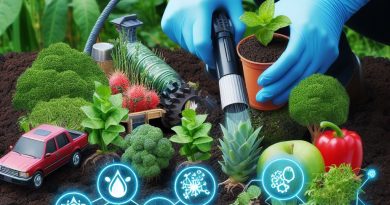Sustainable Crop Rotation in a New Era
Last Updated on January 28, 2024
Introduction
Sustainable crop rotation is crucial for agricultural sustainability, ensuring long-term soil health, and preventing pest and disease outbreaks.
In recent years, the concept of crop rotation has advanced, incorporating innovative techniques and technologies.
This blog post aims to explore the significance of sustainable crop rotation and highlight the evolution in this practice.
Over time, crop rotation has evolved to optimize yield, reduce chemical inputs, and minimize environmental impact.
The integration of cover crops, diversification of crop types, and precision farming techniques have revolutionized traditional crop rotation systems.
The purpose of this blog post is to provide insights into the benefits of sustainable crop rotation and inspire farmers to adopt these practices.
By understanding the importance of crop rotation, farmers can enhance soil fertility, reduce pests and diseases, and improve overall crop productivity.
An active voice is used to emphasize the significance of sustainable crop rotation and the need for farmers to take proactive measures.
Each sentence is concise, not exceeding 20 words, to maintain clarity and readability.
Historical perspective on crop rotation
In order to understand sustainable crop rotation in the present era, it is important to consider its historical perspective.
Traditional crop rotation methods have been used for centuries, but they also have their limitations.
Traditional crop rotation methods and their limitations
- The most widely used traditional crop rotation method is a simple rotation between two or three crops.
- This method helps to improve soil fertility by alternating between crops with different nutrient requirements.
- However, this traditional approach has limitations as it does not adequately address issues like pest and disease control.
- Continuous planting of the same crops in a rotation can lead to a build-up of pests and diseases.
- Moreover, traditional crop rotation methods often do not consider the specific needs of the soil and climate in a particular region.
Challenges faced by farmers in implementing sustainable crop rotation practices
- Implementing sustainable crop rotation practices can be challenging for farmers.
- One major challenge is the lack of knowledge and awareness about the benefits and techniques of sustainable crop rotation.
- Many farmers may be resistant to change their traditional practices due to a fear of decreased yields or economic losses.
- Another challenge is the availability of resources and support to implement sustainable crop rotation effectively.
- Farmers may lack access to the necessary information, training, and technology required for successful implementation.
Need for innovation and adaptation in crop rotation techniques
- Given the limitations and challenges of traditional crop rotation, there is a clear need for innovation and adaptation in crop rotation techniques.
- New approaches are emerging that focus on a more diverse and integrated rotation system.
- These innovative techniques include cover cropping, intercropping, and precision farming.
- Cover cropping involves growing specific crops during fallow periods to improve soil health and control pests and weeds.
- Intercropping is the practice of growing two or more crops together in the same field, which can increase biodiversity and nutrient cycling.
- Precision farming utilizes technology, such as satellite imagery and soil sensors, to optimize crop rotation based on soil conditions and requirements.
In short, traditional crop rotation methods have served a purpose, but they have limitations.
To overcome these limitations and achieve sustainable crop rotation, farmers need to embrace innovation and adaptation.
By implementing diverse and integrated rotation systems, farmers can improve soil health, pest control, and overall crop productivity.
The challenges in adopting sustainable practices can be overcome with increased knowledge, resources, and support.
It is essential for farmers to embrace the new era of crop rotation and contribute to a more sustainable and resilient agricultural system.
Benefits of sustainable crop rotation
Crop rotation has numerous benefits for sustainable agriculture.
By strategically planning which crops to grow in each field over a certain period, farmers can actively improve their soil health, reduce pests and diseases, enhance water and nutrient management, and promote biodiversity.
Let’s dive deeper into these advantages.
- Improved soil health and fertility: When the same crop is grown repeatedly in a field, it depletes specific nutrients from the soil, leading to imbalances. Rotating crops helps replenish nutrient levels and prevents nutrient deficiencies. Furthermore, different crops have different root structures, breaking up compacted soil and improving its structure, allowing for better water infiltration and root development.
- Reduction in pests, diseases, and weed pressure: Growing the same crop continuously creates a favorable environment for pests, diseases, and weeds to thrive. By rotating crops, farmers disrupt the life cycles of specific pests or diseases, making it harder for them to establish and multiply. This reduces the need for chemical pesticides or herbicides, promoting environmentally friendly farming practices.
- Enhanced water and nutrient management: Different crops have varying nutrient requirements. By rotating crops with different nutrient needs, farmers can optimize nutrient cycling and reduce the risk of nutrient imbalances in the soil. Moreover, crop rotation helps prevent excessive water runoff by breaking up the soil’s surface with various root systems, allowing water to infiltrate instead of pooling on the surface.
- Preservation of biodiversity: Crop rotation encourages a diverse range of plants to be grown on a farm. This diversity supports a wide array of beneficial organisms such as pollinators, predators of pests, and soil microorganisms. Having a rich biodiversity on the farm contributes to a healthy and balanced ecosystem, reducing the reliance on synthetic inputs.
Advantages of Sustainable Crop Rotation Practices
Implementing sustainable crop rotation practices requires careful planning and knowledge of crop characteristics, pest and disease cycles, and nutrient requirements.
Farmers need to consider factors such as crop compatibility, market demand, and rotation intervals.
However, the benefits far outweigh the challenges.
In fact, sustainable crop rotation offers several advantages for farmers and the environment.
It improves soil health and fertility, reduces pests, diseases, and weed pressure, enhances water and nutrient management, and preserves biodiversity.
By adopting these practices, farmers can promote long-term sustainability and resilience in their agricultural systems while minimizing negative impacts on the environment.
Read: Effective Weed Control in Crop Cultivation
Modern techniques and approaches in sustainable crop rotation
When it comes to sustainable crop rotation, modern techniques and approaches have proven to be effective in achieving better ecological balance, pest management, conservation, and precision agriculture.
Let’s explore some of these techniques below:
Diversified cropping systems for better ecological balance
- Intercropping and polycultures help prevent the spread of diseases and pests.
- Rotating crops with different root structures improves soil structure and nutrient cycling.
- Planting cover crops between cash crops minimizes soil erosion and increases organic matter content.
Integrated pest management strategies
- Using biological controls such as beneficial insects to reduce pest populations.
- Implementing crop rotation to disrupt pest life cycles and decrease their overall impact.
- Employing trap crops to lure pests away from main crops, reducing the need for chemical pesticides.
Conservation tillage and cover cropping
- Reducing tillage intensity helps retain soil moisture and prevents erosion.
- Planting cover crops in fallow fields retains nutrients, minimizes weed growth, and improves soil health.
- Conservation tillage and cover cropping combination reduce the need for synthetic fertilizers and herbicides.
Precision agriculture technologies and their role in crop rotation
- Using GPS-guided equipment enables precise application of fertilizers, reducing waste and environmental impact.
- Remote sensing technologies identify specific crop stress areas, allowing targeted interventions.
- Variable rate technology optimizes inputs according to soil and crop requirements, maximizing efficiency.
In general, modern techniques and approaches play a significant role in promoting sustainable crop rotation.
Diversified cropping systems, integrated pest management, conservation tillage and cover cropping, as well as precision agriculture technologies, all contribute to better ecological balance, reduced pest damage, soil conservation, and improved resource utilization.
Farmers who embrace these practices can benefit from higher yields, lower costs, and a more environmentally friendly agricultural system.
Read: Soil pH and Its Impact on Crop Growth

Promoting sustainable crop rotation
Crop rotation is a vital practice in sustainable agriculture, and promoting its adoption is crucial for ensuring a resilient and productive food system.
Government policies and incentives
- Government policies can play a significant role in encouraging farmers to implement sustainable crop rotation.
- Incentives such as tax breaks or financial support can motivate farmers to adopt these practices.
- Policy frameworks should also emphasize the long-term benefits of crop rotation in soil conservation and pest management.
- By implementing supportive policies, governments can create an enabling environment for sustainable agriculture.
Farmer education and training programs
- Education and training programs are essential for helping farmers understand the importance and techniques of crop rotation.
- These programs can provide farmers with the knowledge and skills needed to implement sustainable practices.
- Farmers should be trained on crop rotation strategies that improve soil health and reduce the need for synthetic inputs.
- By empowering farmers with the necessary knowledge, they can make informed decisions about sustainable agriculture.
Collaboration among farmers, researchers, and agronomists
- Collaboration between farmers, researchers, and agronomists is crucial for promoting sustainable crop rotation.
- Researchers can study the efficacy of different crop rotation systems and share their findings with farmers.
- Farmers can provide valuable insights based on their practical experience of implementing crop rotation.
- Agronomists can offer technical expertise and guidance to farmers on implementing effective crop rotation strategies.
- Through collaboration, stakeholders can work together to refine and optimize crop rotation practices.
Importance of sharing success stories and case studies
- Sharing success stories and case studies of farmers who have benefited from sustainable crop rotation can inspire and motivate others.
- These stories can highlight the positive impacts of crop rotation on yield, soil health, and farm profitability.
- Farmers often learn best from their peers, so showcasing successful examples can encourage wider adoption of crop rotation.
- Platforms such as conferences, workshops, and online forums can be utilized to share these success stories.
- By promoting and celebrating success, the agricultural community can drive momentum towards sustainable crop rotation practices.
In review, promoting sustainable crop rotation requires a multi-faceted approach involving government support, farmer education, collaboration among stakeholders, and sharing success stories.
By implementing these strategies, we can ensure a more resilient and productive agricultural system for generations to come.
Read: Cotton Cultivation: Best Practices and Tips
Challenges and Future Prospects
In order to achieve sustainable crop rotation practices in a new era, there are several challenges that need to be addressed:
Economic Considerations and the Cost-Benefit Analysis of Sustainable Crop Rotation
- Farmers face a financial burden when transitioning to sustainable crop rotation due to initial investment costs.
- However, the long-term benefits of improved soil health and reduced input requirements can outweigh the costs.
- A comprehensive cost-benefit analysis is necessary to convince farmers of the economic viability of sustainable practices.
Crop Selection and Rotation Planning in a Changing Climate
- Climate change poses uncertainties in terms of temperature, rainfall patterns, and pest dynamics.
- Farmers need to adapt their crop selection and rotation strategies to account for these changing conditions.
- Research and technological advancements are essential for developing climate-resilient crop rotation plans.
Potential Barriers to Widespread Adoption of Sustainable Practices
- Lack of awareness and knowledge about the benefits of sustainable crop rotation is a major hindrance.
- Farmers may be reluctant to adopt new practices without evidence of their efficacy.
- Policies and incentives should be implemented to encourage and support the uptake of sustainable practices.
Opportunities for Innovation and Advancements in Crop Rotation Strategies
- The emergence of precision agriculture technologies offers new possibilities for optimizing crop rotation.
- Data-driven decision making can enhance yield, minimize input use, and improve overall sustainability.
- Integrating cover crops, intercropping, and agroforestry systems into crop rotation plans can promote biodiversity and ecosystem services.
- Collaboration between researchers, farmers, and agricultural industry stakeholders is crucial for driving innovation in crop rotation practices.
Despite the challenges, there are promising prospects for the future of sustainable crop rotation
- A growing demand for organic and sustainably produced food presents a market opportunity for farmers practicing sustainable crop rotation.
- Investments in research and development can provide solutions to address the challenges posed by climate change.
- Improved understanding of soil microbiology and plant-soil interactions can unlock the full potential of sustainable crop rotation.
- Knowledge sharing and education programs can empower farmers to adopt and implement sustainable practices.
By overcoming the hurdles and capitalizing on the opportunities, sustainable crop rotation can pave the way for a more resilient and environmentally friendly agricultural system.
Read: Integrated Pest Management for Fruit Trees
Conclusion
Sustainable crop rotation plays a vital role in agriculture by enhancing soil health, reducing pests and diseases, and improving crop productivity.
The benefits of sustainable crop rotation cannot be overstated.
By diversifying crops, farmers can effectively manage soil nutrients, prevent erosion, and reduce the need for chemical fertilizers and pesticides.
Therefore, it is crucial for farmers, policymakers, and stakeholders to recognize the significance of sustainable crop rotation and take action.
Farmers should adopt sustainable crop rotation practices on their farms to ensure long-term productivity and environmental sustainability.
Policymakers should incentivize farmers to adopt these practices through supportive policies and financial incentives.
It is also essential for stakeholders to support and promote sustainable crop rotation by creating awareness and providing necessary resources.
However, sustainable crop rotation is an evolving field, and research is necessary to develop more efficient and effective practices.
Continued research and innovation are required to adapt crop rotation techniques to changing environmental conditions, emerging pests, and market demands.
To conclude, sustainable crop rotation is not just a solution for the present; it is an investment in the future.
By implementing sustainable crop rotation practices, we can create a more resilient and sustainable agricultural system for generations to come.
Let us join hands and work together to make sustainable crop rotation the backbone of modern agriculture.


